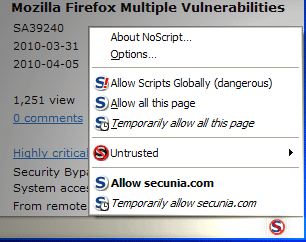Challenges With Script Blockers
Web designers and web surfers, in one particular area, are greatly at odds today. For web designers, making a good website oftentimes requires that multimedia elements are included from  multiple different sources. Video that is embedded on the site rather than hosted on the site’s actual server, advertisements that are served from different domains and other elements may be important to a site, but they are sometimes nuisances to visitors who may go out of their way to eliminate them from a page.
multiple different sources. Video that is embedded on the site rather than hosted on the site’s actual server, advertisements that are served from different domains and other elements may be important to a site, but they are sometimes nuisances to visitors who may go out of their way to eliminate them from a page.
The Issue
For web surfers, among the biggest threats on the Internet is the content on their favorite webpages that is served from other domains. This type of content has been used in the past as a vector for malicious software and, on top of that, many Web servers find advertisements and some multimedia elements to be nuisances. This leads them to use various script blocking technologies, such as NotScripts for Google Chrome and NoScripts for Firefox.
This script blocking software sometimes requires that the user manually approve each instance of a scripted piece of content on a page that they are viewing. This allows them – if they are savvy enough – to select only the content that they wish and to block out advertisements and other types of content.
For web designers who may have spent many hours developing a site to accommodate some of the content that users are simply blocking these days, this can be frustrating. Investing time in getting a message across and having it utterly ignored is certainly not morale boosting for web designers.
Solutions
The first thing web designers will benefit from taking into consideration is simply the fact that much of what they include on a page is likely to be blocked out – intentionally – by visitors these days. This can make a more minimalist design a good idea, since crowding a page with advertisements and other content will simply do no good whatsoever if a visitor is blocking out as much of it as they can.
Another solution is to acknowledge that many visitors will be using script blocking technology and to make the site accessible for them. For example, simply tagging a piece of multimedia with a text tag that lets people know that they need to enable scripts on whatever domain applies to view that content can go a long way toward helping them enjoy the page. It also makes it apparent that the page owner takes visitor needs seriously and tries to accommodate them.


